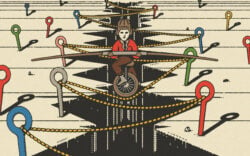If you’re into sampling, you may have tried techniques like chopping, stretching, and reversing before.
However, the reality is that there are a lot more ways you can manipulate a sample. In the tutorial video above, we explore the following three advanced sampling techniques that you need to try out in your own productions.
1. Mix and match
Have you ever tried weaving together multiple samples from entirely different sources? Daft Punk are a great reference point for this craft, with tracks like “Too Long” combining clips from different sonic universes—specifically Rose Royce’s “First Come, First Serve” and Maze and Frankie Beverly’s “Running Away.”
In our video, we analyze how Daft Punk might have processed these samples to work together. From there, we open up Bitwig Studio and mix and match two different tracks of our choosing.
Go to 0:15 in the video to learn more about how to mix and match samples.
2. Resampling
Resampling describes a process where you take a source sample, add further effects processing, and then record it as a new sample. You can do this in any DAW by loading your source sample onto an audio track. From there, add a second audio track, set the input to be your source sample, and then arm the track. Finally, load some of your favorite sound design plugins onto your source track, and then just have some fun—experiment with parameters and see what you get.
Resampling can be a particularly powerful source for unique percussion loops and melodic ear candy. In the tutorial, we demonstrate this by using a combination of Minimal Audio’s Rift, Sugar Bytes’ Turnado, DAW-native tools, and our new mobile app, CoSo.
This article features an older version of our app—learn more about all of the latest features, and download the new Splice mobile app here.
Go to 3:32 in the video to learn more about resampling.
3. Granular synthesis
Last but not least is granular synthesis. This is a technique that somewhat blurs the lines between sampling and synthesis, as it’s a process where you sample incredibly small grains of audio (generally <100 ms) to transform virtually any sound into a melodic instrument.
In the video, we explore the granular synthesis tools across Bitwig Studio, Arturia’s Pigments, and Astra. The timbres we started with compared against the sounds we ended up with might surprise you.
Go to 6:20 in the video to learn more about granular synthesis.
What are your favorite advanced sampling techniques?
We hope this video inspired you to try something new in your next production. If you enjoyed the various loops and one-shots used throughout this tutorial, you can find them all in this Collection.
Which of these advanced sampling techniques was your favorite? Are there any other interesting techniques that we missed? Let us know in the comments section of the video, and subscribe to the Splice YouTube channel for more production tips and tutorials.
Try Bitwig Studio for free, and then Rent-to-Own the DAW until you own it outright:
May 7, 2022

.svg)
.svg)



